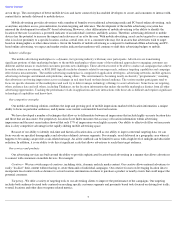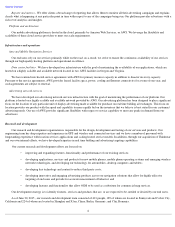TeleNav 2015 Annual Report Download - page 20
Download and view the complete annual report
Please find page 20 of the 2015 TeleNav annual report below. You can navigate through the pages in the report by either clicking on the pages listed below, or by using the keyword search tool below to find specific information within the annual report.
Table of Contents
those solutions. If automobile manufacturers and OEMs do not believe that our services meet their customers’ needs, our products and services
may not be designed in to future model year vehicles.
The design and sales cycle for on-board or brought-in automotive navigation services and products is substantially longer than those
associated with our mobile navigation services to customers of wireless carriers or our advertising platform services. As a result, we may not be
able to achieve significant revenue growth with new customers from the automotive navigation business in a short period of time, or at all. For
example, design wins for vehicles may be awarded 12 to 36 months prior to the anticipated commercial launch of the vehicle. Our relationship
with GM includes brought-in services for vehicles and in January 2015 GM launched the new version of its OnStar RemoteLink® mobile
application, but we cannot assure you that the RemoteLink® project will lead to us receiving significant revenue in the short-term, if at all. We
also entered into a contract with GM to provide its worldwide connected navigation services beginning with select model year 2017 vehicles. We
do not expect to receive any revenue from the launch of those vehicles until fiscal 2017 at the earliest, and in the course of the development of
those vehicles we may be designed out altogether. We cannot assure you that when and if our products go into production and launch in GM
vehicles and become available for sale, they will be in a wide variety of geographic markets in which GM sells vehicles in or across a variety of
models and brands. GM has not provided us with any volume or revenue guarantees. In July 2015, we and Toyota announced a partnership for
brought-in navigation services where our Scout GPS Link will be available first in the model year 2016 Toyota Tacoma, and subsequently in
other Entune™ Audio Plus equipped model year 2016 Toyota vehicles in the United States. We cannot assure you that the Scout GPS Link
Toyota project will lead to us receiving significant revenue in the short-term, if at all.
As we have limited experience in the automotive navigation market, we also may not price our solutions in such a way that is profitable for
us and enables us to recoup the development expenses we incurred to provide such solutions in the time we expect or at all. Development
schedules for automotive navigation products are difficult to predict, and there can be no assurance that we will achieve timely delivery of these
products to our customers. To the extent that we charge service fees beyond an initial fee at the time the vehicle is purchased, we may not be
successful in gaining traction with customers to provide services and charge ongoing monthly or annual fees outside of the traditional on-board
navigation service model. Our map, POI and other content costs for our automobile navigation solutions are higher than those we have
historically paid for our mobile phone-based navigation services and to date we have not been able to use OSM offerings for automotive
navigation. If we are unable to improve our margins, we may not be able to operate our automobile navigation business profitably. If we fail to
achieve revenue growth in any of our automotive navigation solutions (whether on-board, brought-in or other), we may be unable to achieve the
benefits of revenue diversification. In addition, our third party automotive and mobile navigation content suppliers, HERE and TomTom, are
also becoming competitors with their own automotive navigation services offerings.
As our offerings in automobile navigation expand to brought-in, as well as built-in, we may not correctly anticipate the financial
accounting treatment for the various products. We could be required to amortize revenue from products over time although we previously
recognized revenue for similar products when the applicable vehicle was sold.
We may be unable to enter into agreements to provide automobile navigation products if we do not offer navigation products that serve
geographies throughout the world or automobile manufacturers and OEMs are uncomfortable with our ability to support markets outside of the
United States. Our automobile manufacturer and OEM customers may choose to partner with providers of location services with extensive
international operations. We may be at a disadvantage to attracting such customers due to our business being concentrated in the United States.
Ford only recently began offering vehicles with our solutions outside of the United States and we may not be successful in those geographies if
customers are uncomfortable with the look and feel of our solutions. If we are unable to attract or retain such automobile manufacturer and OEM
customers, our revenue and operating results will be negatively affected.
Our ability to build demand for our automobile navigation products is also dependent upon our ability to provide the products in a cost
effective manner, which may require us to renegotiate map and POI content relationships to address the specific demands of on-
board navigation
applications.
Our multi-platform products are new and may not find market acceptance.
We introduced Scout, a service that end users can access for navigation and planning with their mobile phones and cars. We have not
previously offered a planning service or a service that spans different platforms. We cannot assure you that automobile manufacturers and end
users will accept our Scout service or, even if they do, that end users will adopt and use this service, which encompasses services different than
our historical strength in navigation, or that we will be able to generate sufficient revenue from Scout to offset its costs. If we fail to develop
innovative products that automobile manufacturers and end users adopt, our operating results and financial condition could be harmed. Further,
Google and Apple have each developed technology platforms that they are marketing to auto manufacturers. If auto manufacturers adopt these
platforms, they may also adopt Google and Apple’s navigation services that run on these platforms and if so, consumers may elect to use these
free service offerings rather than pay for our products which are currently sold by Ford as new car features with substantial cost to the consumer.
14
























